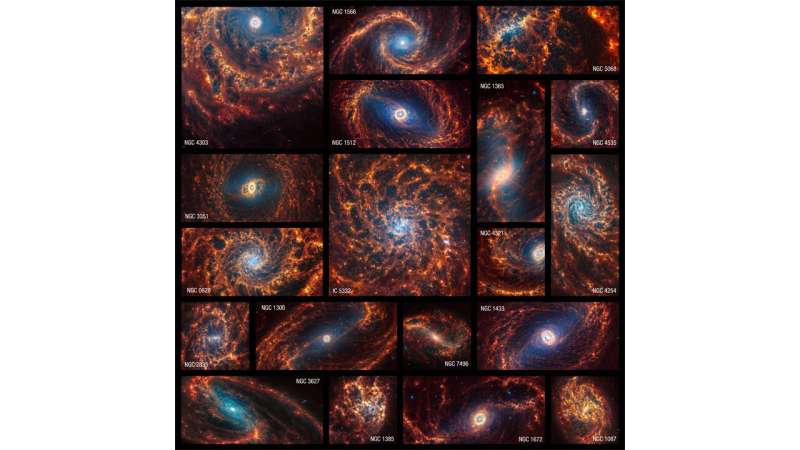The middle one looks like estimations for Triton. I know it sounds a little ridiculous though you have to remember its not like someone can go out there and verify things yet. For all we know there could be a star above Triton and all that since space is not perfectly flat like we see on diagrams. I still believe they took a general estimation of Andromeda and applied it for simplicity to the Milky Way. Maybe some day the actual height and width of our own galaxy can be verified.weatheriscool wrote: ↑Thu Jul 06, 2023 11:47 pm The 25 Best James Webb Space Telescope Images So Far
https://www.extremetech.com/science/the ... ges-so-far
Webb has two decades ahead of it, but it's already captured some stunning images.
By Ryan Whitwam July 6, 2023JupiterThe James Webb Space Telescope took decades to design and build, but that herculean effort is already paying off. Scarcely a year on the job, and Webb is already sending back stunning cosmic vistas, complete with a raft of scientific data that has helped scientists advance their understanding of the universe. The telescope may operate for 20 years, but let's look over the highlights of Webb's first year on the job. Here, in no particular order, are the 25 best Webb images to date.
Neptune
Saturn
James Webb Space Telescope (JWST)
Re: James Webb Space Telescope (JWST)
To know is essentially the same as not knowing. The only thing that occurs is the rearrangement of atoms in your brain.
-
Nanotechandmorefuture
- Posts: 478
- Joined: Fri Sep 17, 2021 6:15 pm
- Location: At the moment Miami, FL
Re: James Webb Space Telescope (JWST)
Re: James Webb Space Telescope (JWST)
The James Webb Space Telescope and an Amonia Trail to Exoplanets
November 11, 2023
Extract:
November 11, 2023
Extract:
Read more here: https://www.eurasiareview.com/09112023 ... planets/(Eurasia Review) Isotopes and isotopologues – molecules that differ only in the composition of their isotopes –…play an increasingly important role in astronomy. For example, the ratio of carbon-12 (12C) to carbon-13 (13C) isotopes in the atmosphere of an exoplanet allows scientists to infer the distance at which the exoplanet orbits its central star.
Until now, 12C and 13C bound in carbon monoxide were the only isotopologues that could be measured in the atmosphere of an exoplanet. Now a team of researchers has succeeded in detecting ammonia isotopologues in the atmosphere of a cold brown dwarf. As the team has just reported in the journal Nature, ammonia could be measured in the form of 14NH3 and 15NH3….
In search of ammonia
Brown dwarfs are somewhere in between stars and planets: they resemble giant gas planets in many ways, which is why they can be used as a model system to study gas giants. In their work, (astrophysicist Polychronis) Patapis and colleagues observed a brown dwarf, called WISE J1828, that’s 32.5 light years away from Earth; in the night sky, it is located in the constellation Lyra, the lyre. WISE J1828 cannot be seen with the naked eye: with an effective temperature (that is, the temperature of a blackbody that would emit the same amount of energy as the observed object) of only 100°C, it is far too cold for hydrogen fusion to take place and send light all the way to Earth. To spot this ultracold dwarf star of the Y spectral class, the mirrors of the James Webb Space Telescope (JWST) were turned in the direction of the lyre last summer.
The Mid-InfraRed Instrument (MIRI), an infrared detector installed on board the JWST, made it possible to reveal the ammonia isotopologues on WISE J1828. In the wavelength range between 4.9 and 27.9 μm, the Medium Resolution Spectrometer (MRS) of MIRI recorded a spectrum of the brown dwarf where, in addition to ammonia, the researchers observed water and methane molecules, each with characteristic absorption bands.
…
The ammonia trail only became tangible thanks to the JWST, confirming once again the enormous value and unparalleled performance of this space telescope
Don't mourn, organize.
-Joe Hill
-Joe Hill
-
weatheriscool
- Posts: 13583
- Joined: Sun May 16, 2021 6:16 pm
Re: James Webb Space Telescope (JWST)
NASA's Webb depicts staggering structure in 19 nearby spiral galaxies
https://phys.org/news/2024-01-nasa-webb ... earby.html
by Space Telescope Science Institute
https://phys.org/news/2024-01-nasa-webb ... earby.html
by Space Telescope Science Institute
A new treasure trove of Webb images has arrived. Near- and mid-infrared images show off every facet of these face-on spiral galaxies.
Humanity has spent centuries mapping Earth's features—and we frequently repeat the process by using more advanced instruments. When we combine the data, we get a more complete understanding of our planet.
Now, look outward into space. Astronomers have observed nearby, face-on spiral galaxies for decades. Both space- and ground-based telescopes have contributed to a cache of data in wavelengths from radio to ultraviolet light. Astronomers have long planned to use NASA's James Webb Space Telescope to obtain the highest resolution near- and mid-infrared images ever taken of these galaxies, and today they are publicly available.


